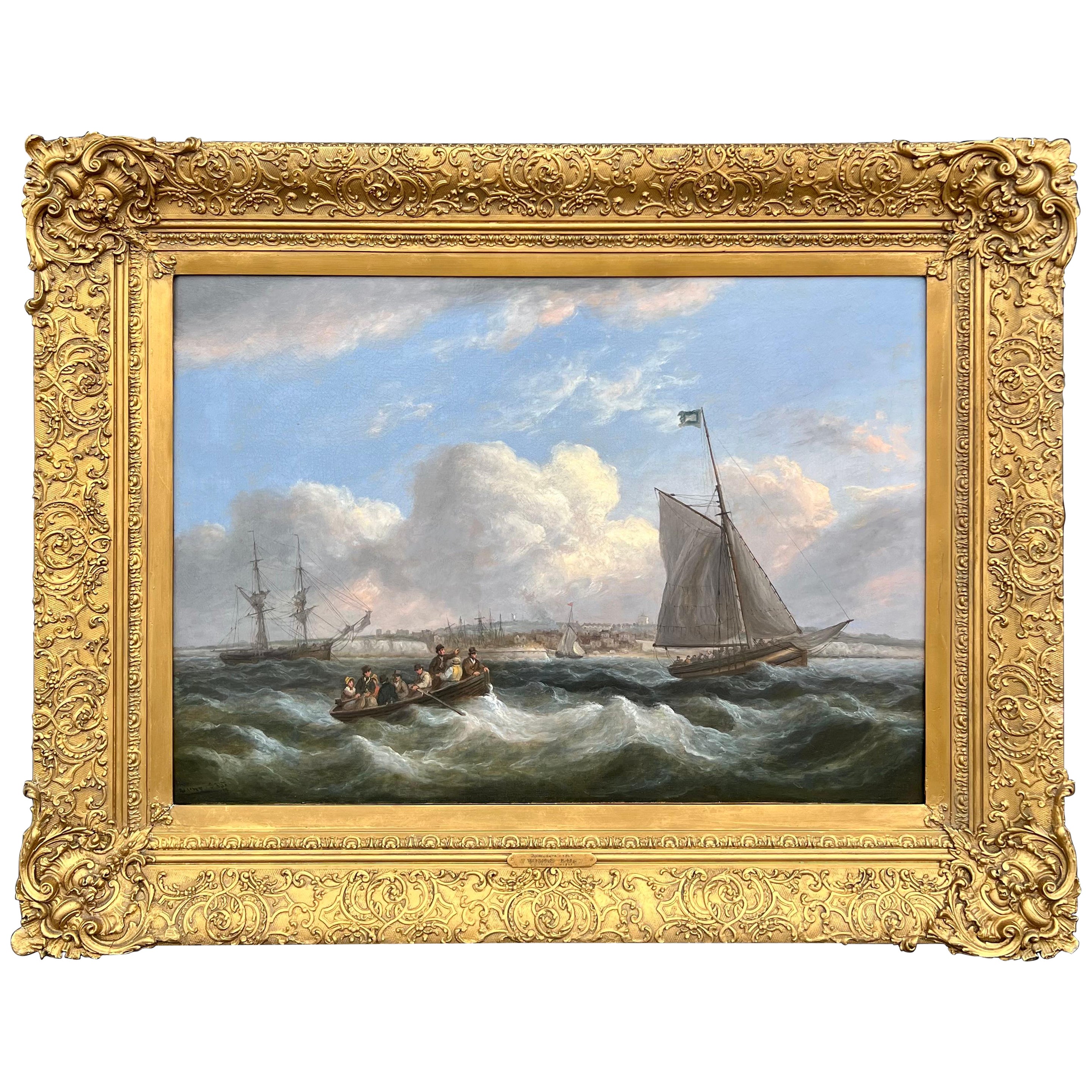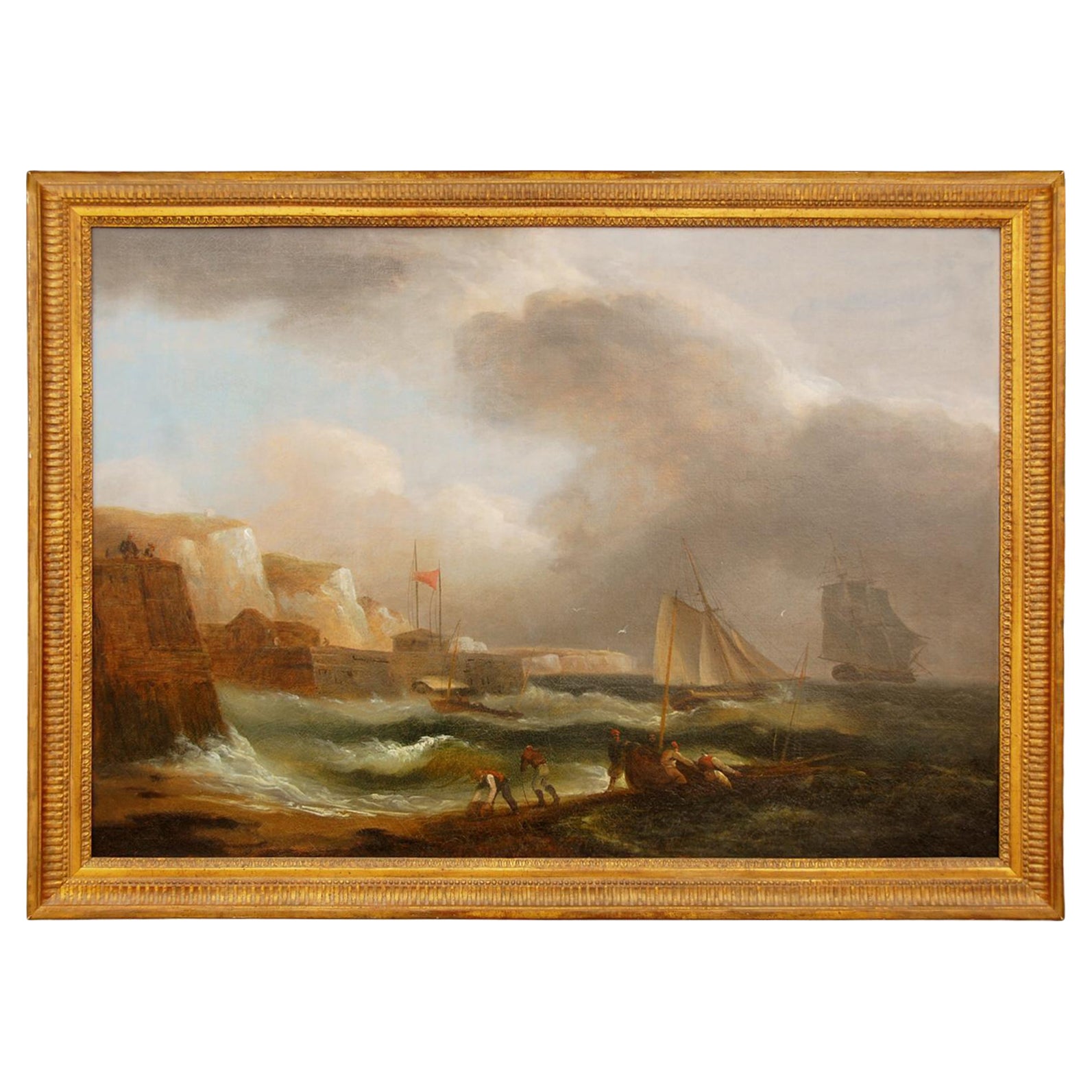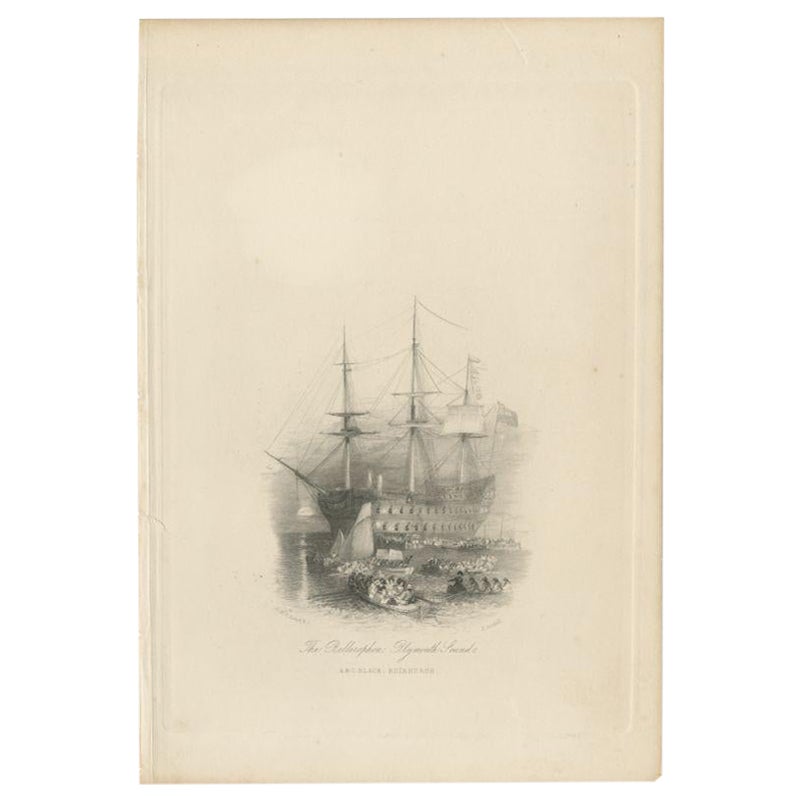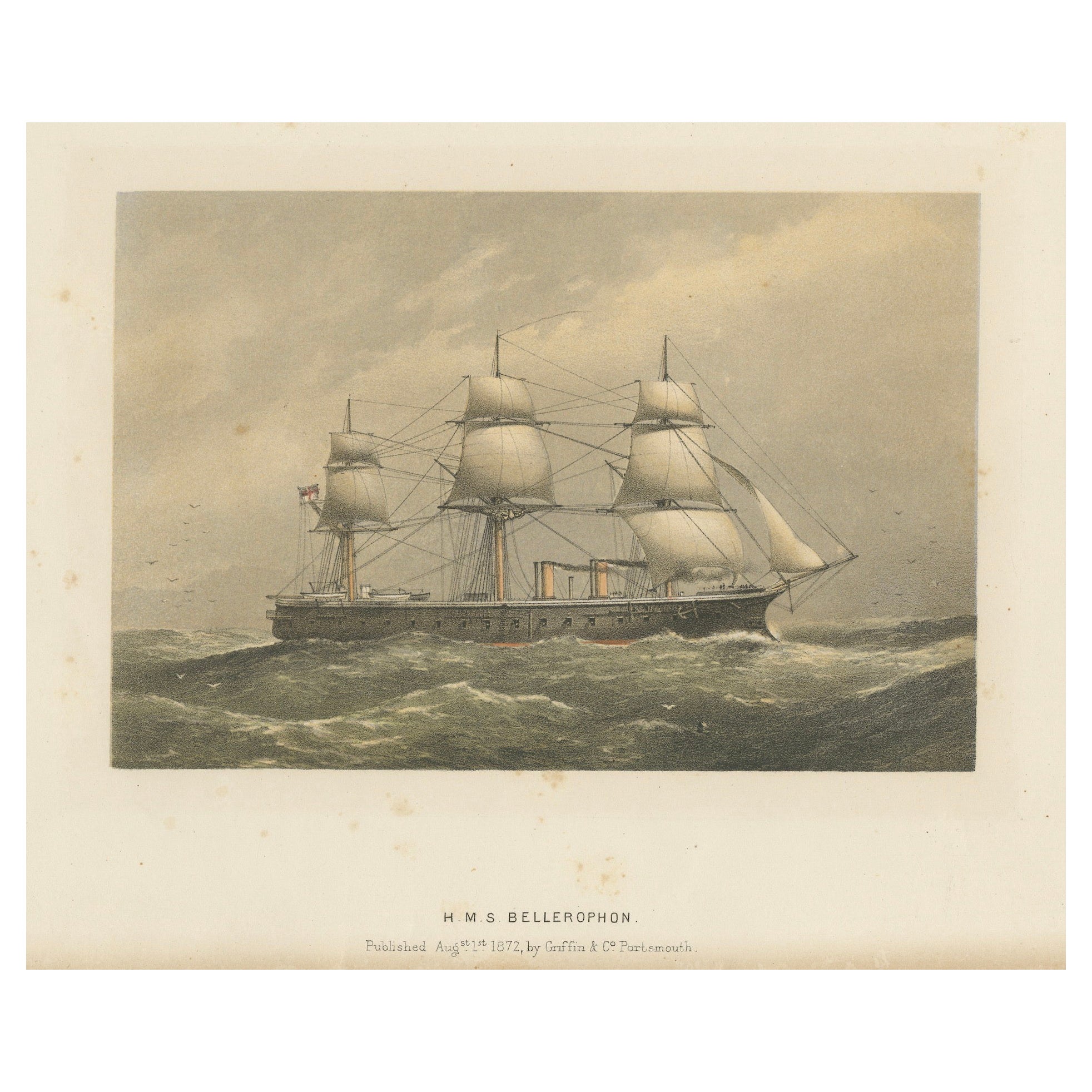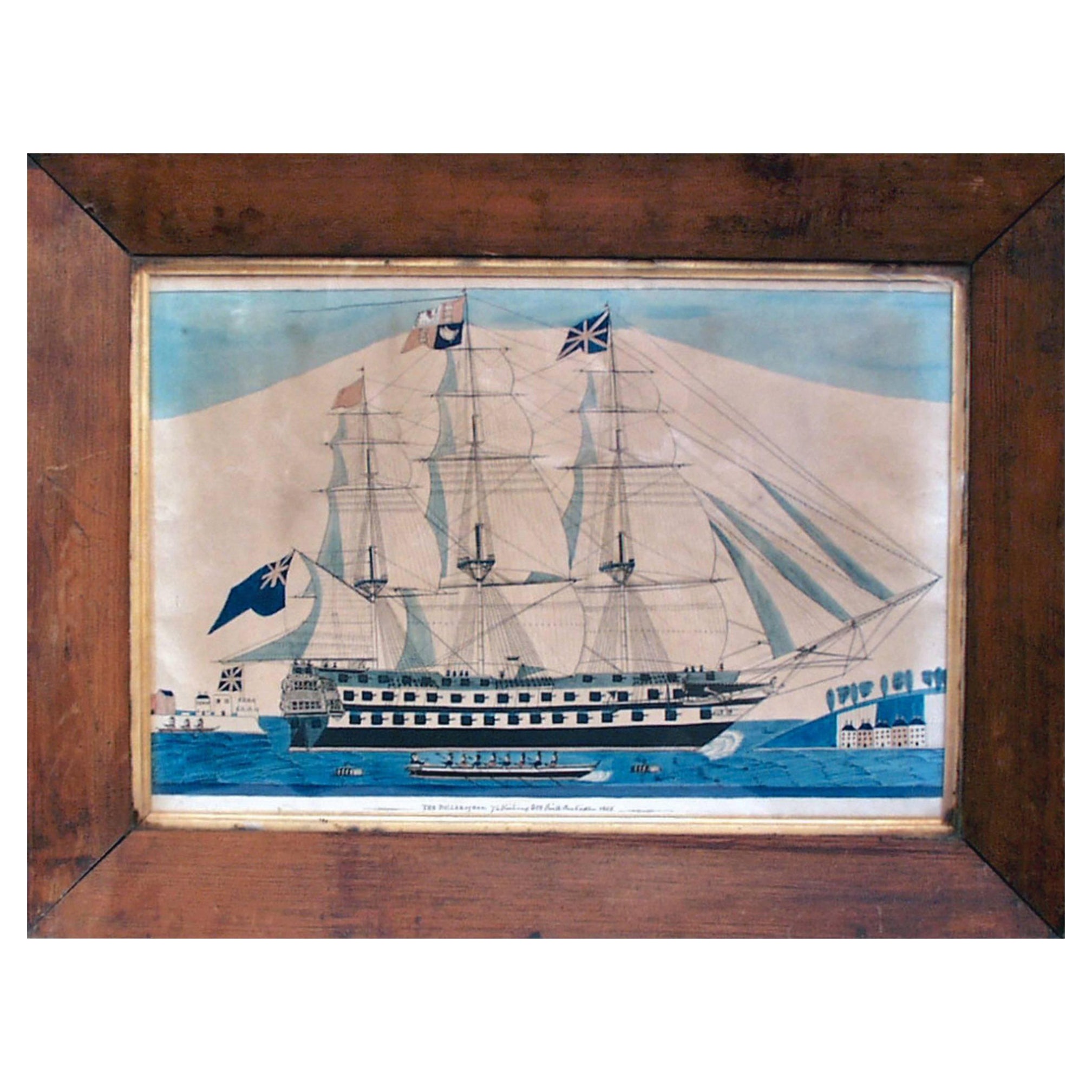Items Similar to Thomas Luny, Hms Bellerophon Leaving Torbay with the Defeated Emperor Napoleon
Want more images or videos?
Request additional images or videos from the seller
1 of 13
Thomas Luny, Hms Bellerophon Leaving Torbay with the Defeated Emperor Napoleon
About the Item
Thomas Luny (British, 1759-1837) HMS Bellerophon leaving Torbay with the defeated Emperor Napoleon aboard, 26th July 1815, this oil on panel shows the crew manning the yards to bring in the sails, having just dropped anchor in Torbay, with another battleship anchored astern and a further ship under sail in the distance, the foreground with working boats approaching, signed and dated ‘Luny 1827’(lower left). In the original gilt-wood frame.
Provenance: Private collection, UK.
Footnote: Despite a service career as illustrious as any fighting ship in the Royal Navy, Bellerophon is principally remembered as the vessel to whose captain Emperor Napoleon surrendered after Waterloo and which then conveyed him to Plymouth, via Torbay, on the first stage of his long journey into exile.
One of the fourteen ‘Arrogant’ class 74-gun Third Rates designed by Surveyor Slade in 1758, Bellerophon was built in Edward Greaves’ yard on the Medway at Frindsbury, near Rochester, where her keel was laid in May 1782. Launched on 17th October 1786, she was measured by her builder at 1,613 tons and was 168 feet in length with a 47 foot beam. Completed at Chatham in March 1787 at a total cost of £38,608, she was laid up for three years until fitted for sea in August 1790 and commissioned under Captain Thomas Pasley. By 1794 Pasley had been promoted to Rear-Admiral and Bellerophon acted as his flagship at the battle of the ‘Glorious First of June’ where she engaged the huge 110-gun Révolutionnaire alone for an hour-and-a-half before the Russell and the Marlborough came to her assistance. Because of the damage she had sustained aloft, Bellerophon had then to withdraw from the scene but her conduct at this opening fleet action of the War laid the foundations for what was to follow.
By the time Nelson located the French fleet anchored in Aboukir Bay on 1st August 1798, Bellerophon was commanded by Captain Henry Derby and when he took his ship in to engage the enemy she found herself pitted against Admiral Bruey’s 120-gun flagship L’Orient. In a fierce action exactly reminiscent of what had happened at the ‘Glorious First of June’, Bellerophon pounded her greatly superior adversary but was completely dismasted in so doing. Despite heavy casualties, including Captain Derby, she remained at her station and was the nearest vessel to L’Orient when the latter finally blew up during the night. Repaired and refitted, she was continually in action until Trafalgar where, under Captain John Cooke, she fought nobly, first against the combined fire of four enemy vessels, then in a spectacular duel with L’Aigle and, finally, with the Spanish Monarca which surrendered to her. Her gallant fight cost her the second highest casualty list at the battle and amongst the dead was Captain Cooke himself.
After extensive repairs at Plymouth, she returned to sea and, by the War end, it was said that “during the period 1793-1815, she saw more action than any other ship.” Her enduring claim to fame however came when, after fleeing the field at Waterloo, the defeated Emperor Napoleon made his way to Rochefort where, on 15th July [1815], he surrendered to Captain Maitland of the Bellerophon. Maitland had been sent to Rochefort when intelligence reached the Admiralty that Napoleon was planning to embark there for America; in the event, the Emperor chose to place himself under the protection of British law, whereupon Maitland sailed for England, Napoleon catching his final glimpse of the French coast (off Ushant) on 23rd July. The English coast was sighted the same evening and, early the next morning, Bellerophon anchored in Torbay where Maitland awaited his orders. As soon as news of the former Emperor’s arrival became known, presumably by means of a careless word ashore from one of the ship’s officers, large numbers of small craft packed with curious spectators made for the ship and provided a carnival atmosphere all around her. Two days later, on the 26th, Maitland weighed anchor for Plymouth where he and his celebrated passenger arrived within hours; Napoleon remained aboard Bellerophon for twelve days whilst the government decided what to do with him and, on 7th August, he transferred into H.M.S. Northumberland and embarked for St. Helena and exile. With the War over and the need for warships sharply decreased, Bellerophon was afterwards fitted out as a convict hulk and served thus for the remainder of her career, being renamed Captivity in 1824, until broken up in 1836.
- Dimensions:Height: 19.5 in (49.53 cm)Width: 23 in (58.42 cm)Depth: 0.1 in (2.54 mm)
- Materials and Techniques:
- Place of Origin:
- Period:
- Date of Manufacture:1827
- Condition:Wear consistent with age and use.
- Seller Location:Lymington, GB
- Reference Number:1stDibs: LU973024369312
About the Seller
5.0
Recognized Seller
These prestigious sellers are industry leaders and represent the highest echelon for item quality and design.
Established in 1982
1stDibs seller since 2013
109 sales on 1stDibs
Typical response time: <1 hour
Associations
LAPADA - The Association of Arts & Antiques Dealers
- ShippingRetrieving quote...Ships From: Lymington, United Kingdom
- Return PolicyA return for this item may be initiated within 14 days of delivery.
More From This SellerView All
- Thomas Whitcombe ‘Flora’Located in Lymington, HampshireThomas Whitcombe: ‘Flora’, this oil on canvas shows the action, within a gilt frame with a panel reading ‘British Frigate “Flora”, 36 guns commanded b...Category
Antique 1780s English Paintings
MaterialsCanvas, Paint
- A small oil painting of a fishing boat leaving Calais Harbour by E W CookeBy Edward William CookeLocated in Lymington, HampshireA rediscovered small oil painting of a fishing boat leaving Calais Harbour by E W Cooke, depicting a fishing boat from Trouville battling stormy seas as it a...Category
Antique 1810s English Paintings
MaterialsPaint
- Pair of Watercolours by 'Albert' Gordon Thomas R.S.WLocated in Lymington, HampshireA pair of watercolours by (Albert) Gordon Thomas R.S.W ( 1893-1970), one titled ‘Summer Afternoon Weymouth’showing a gentleman’s motor yacht in the foreground and the other ‘Yachts a...Category
Vintage 1960s English Paintings
MaterialsPaint, Paper
- ‘The Ark & the Dove off the Scillies with Lord Baltimore aboard’ Montague DawsonBy Montague DawsonLocated in Lymington, Hampshire‘The Ark and the Dove off the Scillies with Lord Baltimore aboard’ by Montague Dawson, reputedly a commission for the White House, oil on board, showing the two ships of Cecilius Ca...Category
Vintage 1960s English Paintings
MaterialsPaint
- Carved and Painted Model of Hms Emerald, 1811 and ‘Hms Emerald & Hms AmethystLocated in Lymington, HampshireA carved and painted model of HMS Emerald, 1811, the frigate finely modelled and painted with a white hull, black plimsole line, yellow topsides and red cannon ports, raised on the original mahogany stand with turned feet and a plaque reading ‘HMSEmerald, 36 Gun Frigate. Launched on the Thames in 1795. A scale model ½”-1’ made for Captain F. L .Maitland, her Commander 1806-1911 together with a painting of H.M.S. Emerald by Nicholas Pocock...Category
Antique 19th Century British Models and Miniatures
MaterialsPaint
- The Picnic, Island Belle, & the schooner Harry L Belden, Nantucket Harbour, U.S.Located in Lymington, HampshireThe Picnic, Island Belle, & the schooner Harry L Belden, Nantucket Harbour, U.S.A. (circa 1890) by K. A. Griffin, watercolour on paper, showing a steam launch filled with day tripper...Category
Antique Late 19th Century English Paintings
MaterialsPaint
You May Also Like
- "Shipping Off the Coast" by Thomas LunyBy Thomas LunyLocated in Wiscasset, MEShipping off the coast by English artist Thomas Luny. Oil on canvas signed and dated 35' in the lower left. Nice period and possibly original frame. Thomas Luny (1759–1837), born in Cornwall, probably at St Ewe, was an English artist and painter, mostly of seascapes and other marine-based works. At the age of eleven, Luny left Cornwall to live in London. There he became the apprentice of Francis Holman, a marine painter who would have a great and long lasting artistic influence on Luny: Luny remained until 1780 in Holman's London studio, which, was first situated in Broad Street, St. George's, and later relocated to Old Gravel Lane. Examples of his work are exhibited at the National Maritime Museum at Greenwich, in the Royal Albert Memorial Museum in Exeter, and at The Mariners' Museum in Newport...Category
Antique 1830s English Victorian Paintings
MaterialsPaint
- English Georgian Thomas Luny Original Oil "Retrieving the Grog before the Storm"By Thomas LunyLocated in Wells, MEEnglish original oil painting on canvas "Retrieving the Grog Before the Storm"; signed lower left: Thomas LUNY; and indistinctly dated--only a "2" is discernable. This dramatic painting depicts ships outward bound while smugglers in the foreground heave their small boat to shore while others roll a barrel of grog to safety. The sea is building while the white cliffs and stone fortress at the entrance to a harbor stand firm against the impending storm. This is quintessential Luny, displaying his deft handling of the ocean and the exposition of coastal life in the early 19th century. We have had this painting cleaned, rebacked and restored by Northeast Painting Conservation, York, Maine. Thomas Luny (1759-1837), was born in Cornwall but moved to London at an early age and was raised there by his parents, Thomas and Elizabeth. Thomas' father is thought to have been employed in some activity at the London Docks and from thence the younger Thomas was exposed to the maritime world from an early age. He is thought to have been apprenticed to the London artist Francis Holman...Category
Antique Early 19th Century English Georgian Paintings
MaterialsCanvas, Paint
- Antique Print of Napoleon Bonaparte on Board of the HMS BellerophonLocated in Langweer, NLAntique print titled 'The Bellerophon Plymouth Sound'. Steel engraving of Napoleon Bonaparte on board of the HMS Bellerophon in Plymouth Sound. Source unknown, to be determined. A...Category
Antique 19th Century Prints
MaterialsPaper
- Napoleon's Final Voyage: HMS Bellerophon on the Waters of Exile, 1872Located in Langweer, NLThis original antique image is a print depicting the H.M.S. Bellerophon, a ship of the British Royal Navy. The print is rendered in a monochromatic color scheme with subtle hand colo...Category
Antique 1870s Prints
MaterialsPaper
- Watercolor Painting of the Bellerophon, Dated 1855Located in Downingtown, PAThe large watercolor picture depicts the Bellerophon sailing out to sea past South Sea Castle off Spithead. Figures can be seen on board. She flies the Blue Ensign, a Union Jack and the Royal Standard. South Sea Castle is to her left and land with a row of houses on the right. An inscription below reads: The Bellerophon 74 Sailing OFF South Sea Castle 1855 Bellerophon: A Greek hero who, with the help of the winged horse Pegasus slew the monster Chimaera Bellerophon: "Common" 74 gun 3rd Rate. Based on HMS Dublin of 1755, a total of 14 ships of the Bellerophon class were built, and a total of 93 "Common" class vessels were built in all. Mr Timothy Akers MA, B.Sc (Hon's) Maritime Research Archaeologist. An Account of the Fitting out of H.M.S. "Bellerophon." This affords a brilliant example of what can be done in the Navy, when a ship's company are commanded by officers possessing the requisite union of due seamanlike and administrative qualities, and I give it as a high standard by which all such may be measured, and as an appropriate pendant to the first section of our subject. On March 7th, 1847, orders were unexpectedly received for the 90-gun ships "Rodney", Captain Edward Collier...Category
Antique Mid-19th Century English Early Victorian Paintings
MaterialsPaper
- "Bellerophon and Pegasus" Striking Art Deco Painting with Male Nude MythologicalBy Bryson BurroughsLocated in Philadelphia, PAThis remarkable scene depicting the moment when Bellerophon was about to lasso the flying figure of Pegasus after the creature paused for a drink below was painted in 1926 by Bryson ...Category
Vintage 1920s American Art Deco Paintings
MaterialsPaint
Recently Viewed
View AllMore Ways To Browse
Emperor Painting
Antique Painted Furniture Uk
Napoleon Oil
Antique Navy Paint
Wall Fire Place
Napoleon Ship
Napoleon Oil Painting
Fleet Furniture Antique
Antique Ship Anchor Anchors
Antique Ship Anchor
Antique Ship Anchors
Antique Ships Anchor
English 15th
15th Century English
15th Century English
English 15th Century
Antique Sail Boats
Spanish Anchor
